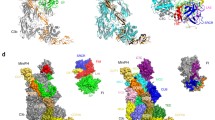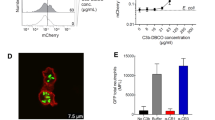Abstract
The binding of C3b, the opsonic fragment of the third component of complement (C3), to bacterial surface structures mediates two events important in host defence: assembly of the C5b-C9 lytic complex and opsonic recognition by phagocytic cells (for reviews see refs 1, 2). These interactions proceed through a labile binding site3 located on the α′ chain of the C3b molecule, with the resultant formation of a covalent oxy-ester bond4,5 in which the acyl group is contributed by the protein. By exposure of a titratable sulphydryl group6,7 an internal thiolester of native C3 has also been localized to the α′ chain. Studies with 14C-methylamine, a nucleophile which is inherently reactive with a thiolester, have further indicated a stoichiometric (1:1) and covalent interaction, again within the α′ chain8–10. After reaction of the native protein with 14C-methylamine and radioalkylation of the exposed sulphydryl with 3H-iodoacetic acid, a 35-residue tryptic peptide has been isolated that yields the sequence -Cys9-Gly-Glu-Glu12- on Edman degradation; tritium counts are released at step 9 (S[3H]-(carboxymethyl)cysteine) and 14C counts at step 12 (γ-glutamyl[14C]methylamide)8. We now present data which directly demonstrate that the second glutamyl residue of the reactive thiolester can, on proteolytic cleavage of the protein, donate its carbonyl group in a transesterification reaction with appropriate acceptor molecules. These results provide a model for analysis of the interactions at the molecular level between surface constituents of microorganisms and C3b.
Similar content being viewed by others
References
Müller-Eberhard, H. J. & Schreiber, R. D. Adv. Immun. 29, 1–53 (1980).
Reid, K. B. M. & Porter, R. R. A. Rev. Biochem. 50, 433–464 (1981).
Müller-Eberhard, H. J., Dalmasso, A. P. & Calcott, M. A. J. exp. Med. 123, 33–54 (1966).
Law, S. K. & Levine, R. P. Proc. natn. Acad. Sci. U.S.A. 74, 2701–2705 (1977).
Law, S. K., Lichtenberg, N. A. & Levine, R. P. J. Immun. 123, 1388–1394 (1979).
Janatova, J., Lorenz, P., Schechter, A. M., Prahl, J. W. & Tack, B. F. Biochemistry 19, 4471–4478 (1980).
Janatova, J., Tack, B. F. & Prahl, J. W. Biochemistry 19, 4479–4485 (1980).
Tack, B. F., Harrison, R. A., Janatova, J., Thomas, M. L. & Prahl, J. W. Proc. natn. Acad. Sci. U.S.A. 77, 5764–5768 (1980).
Pangburn, M. K. & Müller-Eberhard, H. J. J. exp. Med. 152, 1102–1114 (1980).
Howard, J. B. J. biol. Chem. 255, 7082–7084 (1980).
Capel, P. J. A., Groeneboer, O., Grosveld, G. & Pondman, K. H. J. Immun. 121, 2566–2572 (1978).
Sim, R. B., Twose, T. M., Paterson, D. S. & Sim, E. Biochem. J. 193, 115–127 (1981).
Mann, J. et al. J. Immun. 126, 2370–2372 (1981).
Law, S. K., Minich, T. M. & Levine, R. P. Biochemistry 20, 7457–7463 (1981).
Hammer, C. H., Wirtz, G. H., Renfer, L., Gresham H. D. & Tack, B. F. J. biol. Chem. 256, 3995–4006 (1981).
Tack, B. F., Janatova, J., Thomas, M. L., Harrison, R. A. & Hammer, C. H. Meth. Enzym. 80 (in the press).
Trüeb, B., Holenstein, C. G., Fischer, R. W. & Winterhalter, K. H. J. biol. Chem. 255, 6717–6720 (1980).
Gadd, K. J. & Reid, K. B. M. Biochem. J. 195, 471–480 (1981).
Thomas, M. L., Janatova, J., Gray, W. R. & Tack, B. F. Proc. natn. Acad. Sci. U.S.A. 79, 1054–1058 (1982).
Sottrup-Jensen, L., Peterson, T. E. & Magnusson, S. FEBS Lett. 121, 275–279 (1980).
Campbell, R. D., Gagnon, J. & Porter, R. R. Biosci. Rep. 1, 423–429 (1981).
Harrison, R. A., Thomas, M. L. & Tack, B. F. Proc. natn. Acad. Sci. U.S.A. 78, 7388–7392 (1981).
Hostetter, M. K., Thomas, M. L. & Tack, B. F. IXth int. Complement Workshop, Key Biscayne, Florida Molec. Immun. (in the press).
Tack, B. F. & Prahl, J. W. Biochemistry 15, 4513–4521 (1976).
Laemmli, U. K. Nature 227, 680–685 (1970).
Bonner, W. M. & Laskey, R. A. Eur. J. Biochem. 46, 83–88 (1974).
Author information
Authors and Affiliations
Rights and permissions
About this article
Cite this article
Hostetter, M., Thomas, M., Rosen, F. et al. Binding of C3b proceeds by a transesterification reaction at the thiolester site. Nature 298, 72–75 (1982). https://doi.org/10.1038/298072b0
Received:
Accepted:
Issue Date:
DOI: https://doi.org/10.1038/298072b0
- Springer Nature Limited





